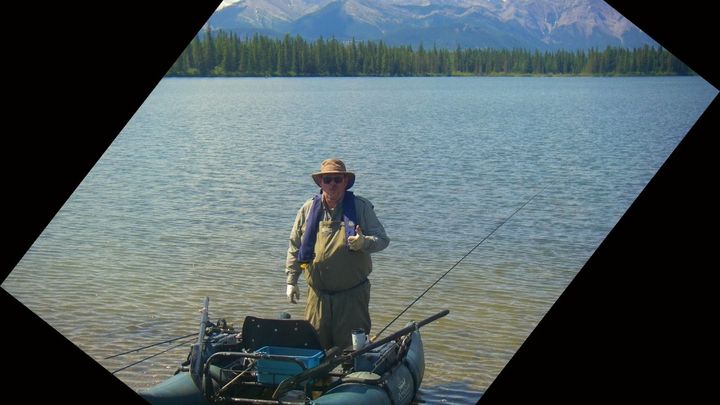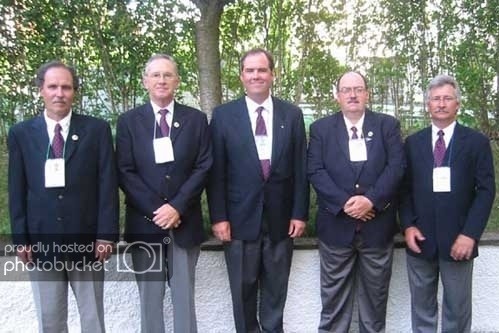
In memory of Malcom (Mac) Stark
Donation protected

Sitting in a Yellowknife bar with my fly-fishing brother Terence, trading stories and sharing laughs over beer and chicken wings, was a casual but fitting way to remember our great friend and mentor Malcolm (Mac) Stark. Three days previously, Mac had passed away peacefully during an extended convalescence following heart surgery.

 Mac was one of those unique people you meet in life who share their knowledge and passion for life through strong opinions, a devil-may-care attitude for what others may think but combined with a wickedly wry and self-deprecating sense of humor. Although Mac was not short on strongly held views, he was always open to other perspectives, and would occasionally change his depending on a well-presented argument. Indeed, his long service as a Justice of Peace in the Northwest Territories (NWT) probably was the reason for his ability to change his mind on issues depending on the strength of evidence or arguments presented, despite his propensity to be an intellectual bulldog.
Mac was one of those unique people you meet in life who share their knowledge and passion for life through strong opinions, a devil-may-care attitude for what others may think but combined with a wickedly wry and self-deprecating sense of humor. Although Mac was not short on strongly held views, he was always open to other perspectives, and would occasionally change his depending on a well-presented argument. Indeed, his long service as a Justice of Peace in the Northwest Territories (NWT) probably was the reason for his ability to change his mind on issues depending on the strength of evidence or arguments presented, despite his propensity to be an intellectual bulldog.
I first met Mac many years ago at the Snowshoe Inn café in Fort Providence, after some persistent urging from my friend Lois who said I had to meet the local manager of the Northern Store – who was also a keen fly fisherman. We talked over several cups of coffee, initially about the limited road-accessible opportunities for fly fishing in the southern Northwest Territories. However, his tone changed, and he became much more animated when he started talking about the Arctic grayling run on the Kakisa River. That winter I convinced my wife that it would be a nice spring camping trip for us and a good opportunity to visit with Lois as well; and that inaugural trip became an annual coming-of-spring event for us.

 The Kakisa River is a world-class Arctic grayling fly fishery. The Arctic grayling is a refined and strikingly beautiful salmonid, with bodies displaying a patterned mix of colors with often an olive-gold band along the belly, with pink iridescence along its flanks changing to silver-blue and occasionally a deep purple along its sides and tail. Mature males adorn a large dorsal fin that includes bright turquoise mottling with sunlit orange along its leading edge. The initiation of the grayling run typically occurs after ice-off on the river during early spring conditions in mid- to late April. The river pristine, its waters clear and cold with banks still lined with shelves of ice and snow, is deceivingly productive. Of note are the myriad mayfly nymphs and boatman that clump and dash about especially around partially submerged boulders along the shoreline once they have been sufficiently warmed by the sun. But the real attraction are the prehistoric looking giant stonefly nymphs, which in various earthy shades of black and brown, represent the single most important food source to the Kakisa grayling in spring. The giant stonefly nymph is a perfect insect for imitating with a fly, because the pattern is big, heavy and doesn’t have to be tied with real-life accuracy. In fact, the bigger and uglier the fly, the better it seems to work.
The Kakisa River is a world-class Arctic grayling fly fishery. The Arctic grayling is a refined and strikingly beautiful salmonid, with bodies displaying a patterned mix of colors with often an olive-gold band along the belly, with pink iridescence along its flanks changing to silver-blue and occasionally a deep purple along its sides and tail. Mature males adorn a large dorsal fin that includes bright turquoise mottling with sunlit orange along its leading edge. The initiation of the grayling run typically occurs after ice-off on the river during early spring conditions in mid- to late April. The river pristine, its waters clear and cold with banks still lined with shelves of ice and snow, is deceivingly productive. Of note are the myriad mayfly nymphs and boatman that clump and dash about especially around partially submerged boulders along the shoreline once they have been sufficiently warmed by the sun. But the real attraction are the prehistoric looking giant stonefly nymphs, which in various earthy shades of black and brown, represent the single most important food source to the Kakisa grayling in spring. The giant stonefly nymph is a perfect insect for imitating with a fly, because the pattern is big, heavy and doesn’t have to be tied with real-life accuracy. In fact, the bigger and uglier the fly, the better it seems to work. 

And in the world of Mac Stark, the giant stonefly nymph was a “man’s fly” that was best fished in tandem under a buoyant float indicator. Here on Mac’s home water was not the place or time to be attempting long distance casts of wedge-shaped loops of fly line. Here you cast flies laden with tungsten beads and lead wire that made them heavy enough to drown a baby duck, and woe was the angler who worried about casting finesse. Nope, according to Mac double hauling a tandem rig with at most two false casts would allow you to attend the serious matter of maximizing fishing time by keeping your flies in the water. “There ain’t no fish in the air!” he would often remark from the bank.




Mac would arrive at our camp early in the morning in his old Dodge truck (which later became a fuchsia Ford, followed by his ‘white lightening’ Ford), stir our black lab Porter in to a frenzy while he was still inside our small tent, and ask why we hadn’t woken up yet and started the cowboy coffee over the campfire. Caffeine, cigarettes, and cheese-injected smokies, which often had the added taste and aromatic hint of lighter fluid, were what fueled Mac’s days on the Kakisa. Mac loved fly fishing, but perhaps even more so, I think he loved sharing days on the water with his many fly fisher friends – friends from Alberta, Quebec, Ontario, and British Columbia all regularly made the trek to fish the Kakisa with Mac. For a few spring seasons, the Kakisa River became an unofficial training venue for many members of Fly Fishing Team Canada.


In 2003, Mac fulfilled a lifetime goal and was selected as a member of Fly Fishing Team Canada to compete at the 23rd FIPS-Mouche World Fly Fishing Championships in Spain. The international travel and drought-like fishing conditions presented him with an arduous, indelible experience that shaped his views on competitive fly-fishing and sparked a commitment to advance the sport in Canada.

In September 2003, he captained Team NWT to a silver medal at the 1st Canadian National Fly Fishing Championship and Conservation Symposium in Russell Manitoba. For a few of us, this competitive fly fishing experience with Mac ‘set the hook’ on our introduction and journey in the sport. He continued to lead Team NWT at multiple Canadian Nationals in Quebec, Ontario, and British Columbia, and captained Team Cormorant to a gold medal at the 2009 Nationals in Fernie, after which he retired from an active role in competitive fly fishing. Mac also served for many years as a Director for Fly Fishing Canada.


Mac had an unwavering conservation ethic, with a focus grounded in practical and sustainable outcomes for fish and wildlife management. He was a lifelong member of Trout Unlimited and the International Game Fish Association, and after his retirement from the Northwest Company at his post in Fort Providence he became more active in fish and wildlife issues. As a representative of the NWT sport fishing sector, he was a member of the Great Slave Lake Advisory Committee (GSLAC). And as a resident hunter, Mac was also a representative of the public at large on the Stakeholders Wildlife Act Advisory Group (SWAAG), which helped contribute to the completion and implementation of a new Wildlife Act in the Northwest Territories.

When it came to Kakisa River grayling, Mac lead the charge for organizing a bunch of us anglers to record their daily catches over multiple years from 2011 to 2013. He used summaries of those data to show that a virtual collapse had occurred in the Kakisa grayling fishery and recommended to Territorial and Federal fisheries managers that grayling possession limits for sport fisherman should have a zero retention for a 5-year period to help in its recovery. Although, the “Kakisa River Initiative” was not implemented, Mac’s work raised the profile of the importance of this fishery to government managers, which was also aligned with concerns expressed by the Ka'a'gee Tu First Nation at Kakisa, NT.


Mac was a leading advocate for responsible access and the Kakisa River grayling fishery was a primary concern. Because some of the best fishing occurs before the official opening of government campgrounds and facilities in May, Mac took a common-sense approach and argued for early opening of Kakisa River Territorial Park facilities so that people could park vehicles and access the river safely and use the outdoor toilets. Although his persistence on this topic may not have made him many friends in the public service, it did provide ongoing benefits to the many of us.

I always considered Mac a teacher at heart, because he was always interested in helping others learn more about fly fishing. He and Wayne – a school principal at Nahanni Butte – regularly organized a field trip for students to come out and spend a day or two fly fishing on the Kakisa during the grayling run in spring. They taught them fly casting, fly tying, and most importantly how to catch and land grayling on a fly rod. I fondly remember volunteering to help Mac and Wayne on a couple of their outings.
As a kid, I was introduced to fly fishing by my Dad and he instilled a love for fish and water. But it was Mac, who I met well in to my adult years who truly unleashed my passion for the sport of fly fishing and kick-started me on my present journey. I know that Mac also had a significant impact on many other friends/fly-fishers across the NWT and Canada.

In tribute to Mac, his dedication to conservation, NWT fly fishing, and his passion for the Kakisa River grayling, this GoFundMe campaign has been set up to pay for a memorial bench to be installed at the Kakisa River Territorial Park in summer 2019. The bench will be installed at a site overlooking the river and have a plaque with the following text engraved on it:
To Honour
Malcolm (Mac) Stark
Husband Friend Flyfisher

https://www.blueimp.com/nav_product/1210/

The objective of this GoFundMe campaign is to raise $1500, of which ~$1200 (estimated) will be used for purchase and installation of the memorial bench as organized by Art Barnes (Hay River, NT). Any funds raised beyond costs will be donated to a youth fly fishing initiative in the NWT, or as otherwise determined by his wife Faye.
Thank-you very much for your consideration of this funding campaign.
Sincerely yours,
John Nishi
Millarville, AB.

Organizer
John Nishi
Organizer
Millarville, AB